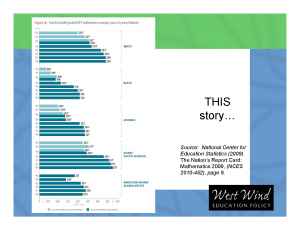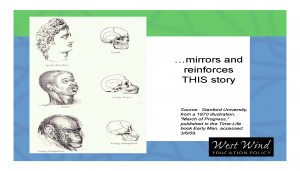Why “Closing Achievement Gaps” Is Not Our Rallying Cry
“Closing achievement gaps.” It’s a catch phrase that has become the rallying cry for equity advocates; the vision that provides the impetus for many education policies, regulations, and programs.
And it’s a catch phrase we are trying desperately not to use.
In our work, we have found that the phrase re-inscribes negative stereotypes about children of color and their families and sends us down the wrong solution path. That is, the way we talk about a problem does several things:
- It locates the source of the problem, which defines the solutions we consider
- It conveys messages to others about what is happening
- While sometimes it debunks beliefs, it most often reinforces them
For example, if we face a problem of underachieving students, almost universally the solution is to fix the kids (i.e., remediation, supplemental Educational Services, double-dosing, Reading First) or to fix the parents (i.e., parent “involvement”). Toting around chart after chart that graphically display differences in performance between white students and students of color rarely signifies for an audience the deep and historic divides between white people and people of color related to access, equity, and outcomes. Instead, it reinforces deficit thinking about students of color and their families. It reinforces a deep-seated myth that “those” children just are not as smart as white children. When we spoke with the National Assessment Governing Board, we shared with them how their representations of racial achievement mirror a figure that was in a prominent publication when I was entering kindergarten.
As long as we are only focusing on underachieving students, we shift the burden/ blame for low achievement onto students, their parents, and their communities. It takes our focus away from the system and puts it at the feet of children as the source of our problems.
Alternatively, if the problem is defined as underserved students, the solution set is different. Understanding the problem this way, we might look for solutions related to targeting resources (per pupil expenditures, equitable distribution of highly qualified teachers) or improving instruction (using formative assessment, differentiating instruction, implementing research-based practice).
How often have you heard someone decry racial achievement gaps in, say, reading, and then go on to focus solely on reading? Probably the most insidious problem with our hyper-focus on “closing achievement gaps” is that when excellence is defined purely as academic achievement, we can have “excellent” schools that still allow for racial insensitivity that harms children. See Tyrone Howard’s TCR article, Who really cares? The disenfranchisement of African American males in PreK–12 schools: A Critical Race Theory perspective,[1] for examples of such lived experiences of students of color. Or go back and read Ann Arnett Fergusons, Bad Boys: Public Schools in the Making of Black Masculinity. Unfortunately, our hyper-attention to test score data narrows our focus and we ignore aspects of the student experience that matter deeply.
Why do we have widespread acknowledgement of racial achievement gaps but not widespread acknowledgement of race?
We are hopeful that explicit work on race could be what will allow us to crack the historic AND PERSISTENT challenges that most US schools have faced in serving children of color. We have seen that when we define the problem we are trying to solve about schooling today as systemic racism, a whole new solution set is opened up to us. Now we can begin to engage in courageous conversations about race[2] and systemic equity leadership as solutions to the problem of historic and persistent inequities.
We have been deeply moved by educators who are willing to examine their own racial identity and their complicity, even collusion, with white privilege—and the children they encounter as they work in earnest to change. Unfortunately, very few of our education policy discussions get to this framing of the problem. Are you tackling systemic racism in your school, school community, or education policies? If so, we’d love to hear and learn from you!
[1] Howard, T.C. (2008). Who really cares? The disenfranchisement of African American males in PreK–12 schools: A Critical Race Theory perspective. Teachers College Record, 110(5).
[2] Check out our colleagues at Pacific Educational Group for a powerful example of a framework for courageous conversations about race.




 The aspiration to “close the gap” in test scores between students of color and whites has been the focus of public policy makers for some time. Policy makers have established the expectation that schools must do more to ensure that all students of every income, race/ethnicity, language background, and disability status graduate from high school ready for college and a career. Schools and the institutions that support schools are under pressure to improve the achievement of all students by improving teacher quality, providing information and supports to parents, establishing standards and assessments, providing intensive supports and interventions to low performing schools, and other reform strategies. There has been an increasing emphasis on closing the gap by improving the quality of teachers and leaders through reforms to educator effectiveness systems including preservice preparation, teacher and leader evaluation, and professional growth systems. In a recent publication, Michael Fullan challenges reformers to think carefully about the way to set the course for these reforms. Choosing the Wrong Drivers for Whole System Reform describes how school leaders and policy makers are selecting the wrong drivers to accomplish the changes needed to increase achievement and close the achievement gap. The article prescribes an alternative set of drivers that have been found to be more effective in accomplishing, what Fullan calls, the moral imperative of raising the bar for all students and closing the gap for lower performing groups. For all students to attain the higher order skills and competencies required to be successful world citizens, drivers need to be pursued as part of a coherent whole and be implemented in a highly interactive way.
The aspiration to “close the gap” in test scores between students of color and whites has been the focus of public policy makers for some time. Policy makers have established the expectation that schools must do more to ensure that all students of every income, race/ethnicity, language background, and disability status graduate from high school ready for college and a career. Schools and the institutions that support schools are under pressure to improve the achievement of all students by improving teacher quality, providing information and supports to parents, establishing standards and assessments, providing intensive supports and interventions to low performing schools, and other reform strategies. There has been an increasing emphasis on closing the gap by improving the quality of teachers and leaders through reforms to educator effectiveness systems including preservice preparation, teacher and leader evaluation, and professional growth systems. In a recent publication, Michael Fullan challenges reformers to think carefully about the way to set the course for these reforms. Choosing the Wrong Drivers for Whole System Reform describes how school leaders and policy makers are selecting the wrong drivers to accomplish the changes needed to increase achievement and close the achievement gap. The article prescribes an alternative set of drivers that have been found to be more effective in accomplishing, what Fullan calls, the moral imperative of raising the bar for all students and closing the gap for lower performing groups. For all students to attain the higher order skills and competencies required to be successful world citizens, drivers need to be pursued as part of a coherent whole and be implemented in a highly interactive way.